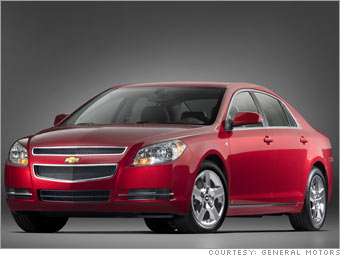Facing that monster is Chevy's job. Chevrolet is GM's bread-and-butter car-and-truck division. Nothing fancy, for the most part. A little more style, perhaps, but nothing too flashy. The focus is on value and quality.
GM's upcoming Malibu probably gives the best idea of what the car maker intends for Chevrolet. For one thing, underneath the sheet metal, it's based on the Saturn Aura. Saturn provided a proving ground for the product, a chance to gauge market and media reaction before a Chevrolet version was rolled out.
For the Malibu, though, GM designers and engineers stripped away the European pretense. The Malibu looks - and is supposed to drive - like an American car. It's bigger and better-looking, both inside and out, than the old Malibu. And it will probably handle and drive better, too.
It's also slightly larger than its competitors. That's another common GM tactic. Whether it's a new midsized sedan, a three-row SUV or a luxury car, GM will usually size up the competition and make their offering a little bigger. If they can match up in every other way then, when you do the final analysis, GM just gives you more metal for your money.
GM has another big hit on its hands with the new three-row SUVs it's now selling as the Saturn Outlook, GMC Acadia and Buick Enclave. Industry newspaper Automotive News is reporting that a version of that vehicle, to be called the Traverse, will come out next year as a 2009 model.
Since it's taking on Toyota directly, and Toyota has made a name for itself as a leader in gas/electric hybrid vehicles, it makes sense that GM has been showing off its most cutting edge powertrain technologies behind Chevrolet bow ties. Assuming it gets released as planned - battery research is still on-going - the Chevrolet Volt could be the first plug-in hybrid to see mass market production.
A small test fleet of hydrogen fuel-cell powered Chevy SUVs should start hitting the streets soon, too, but there is currently no actual production plan for those vehicles.

